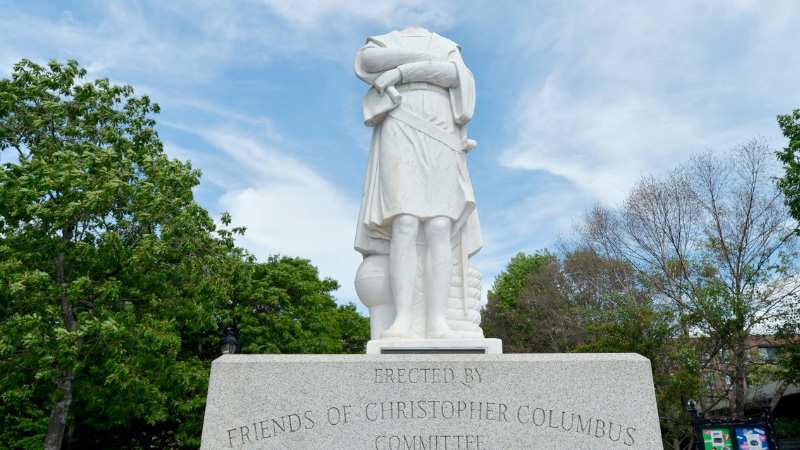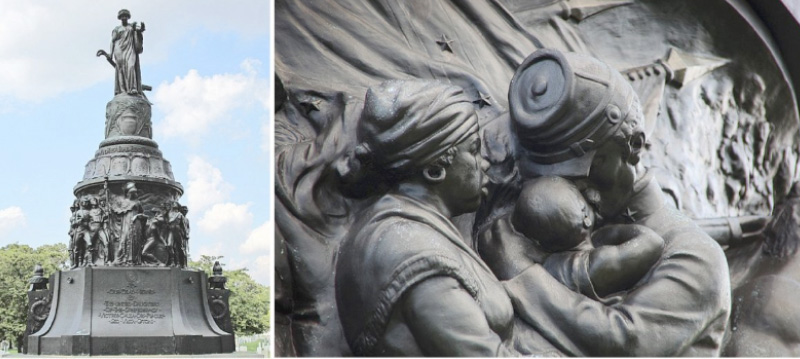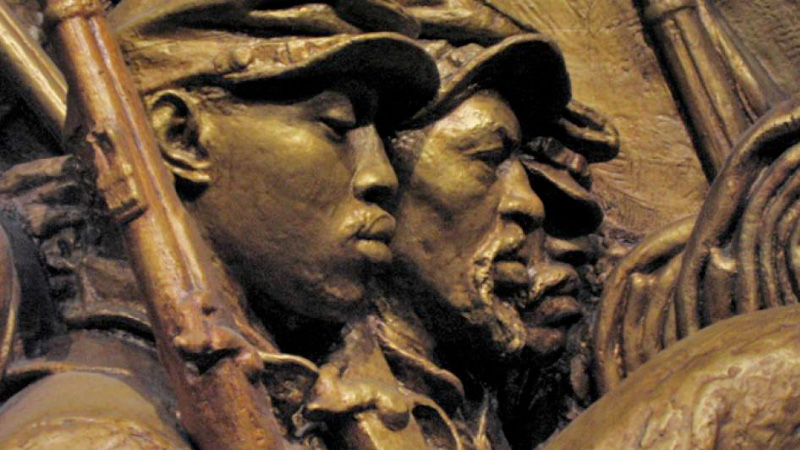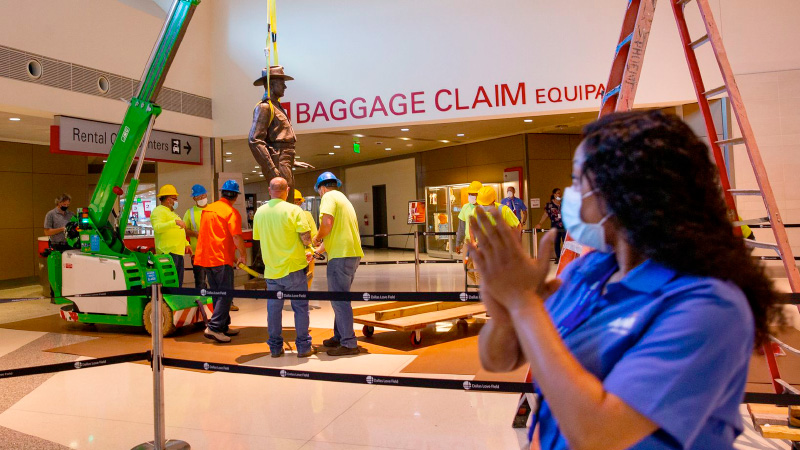In the months following the murder of George Floyd, anti-racist activists across the country demanded the removal of—and in some cases destroyed—Confederate monuments. The events in southern cities such as Birmingham, Mobile, Montgomery, Richmond, Raleigh, Alexandria, and Fredericksburg were especially dramatic, but related actions took place in other regions. And it wasn’t only Confederate monuments that were targeted. In Albany, NY protesters forced the removal of a statue of Major General Philip Schuyler (1733-1804), a Revolutionary War leader, U.S. senator, and major slaveholder. In Boston a statue of Christopher Columbus was beheaded, prompting city officials to remove rather than repair it. In Dallas a Texas Ranger statue titled “One Riot, One Ranger” was removed from a city airport following sustained protests.
These attacks have a distinct political significance: they must be recognized as an intrinsic part of the broader uprising against police violence against Black and Brown people. They have provided an immediate, material focus, and a sense of concrete accomplishment for protests that have so far received promises and expressions of sympathy but little serious systemic change from local, state, and national government.

To those like Trump who have defended the monuments by saying “you can’t erase history,” protesters have answered that statues honoring the Confederacy present a falsified white-supremacist version of history that perpetuates discrimination and oppression.
In the process of taking such statues down, protesters are writing their own history by insisting on critical public recognition not just of the past, but of the present damage these monuments do to people of color. By challenging views of these monuments that see them as acceptable or neutral, protesters have exposed the degree to which Confederate and other racist symbols serve as rallying sites for violent far-right groups. The neo-fascists and white-supremacists who marched in Charlottesville in August 2017 chanting “you will not replace us” were demanding, among other things, that the City Council revoke a decision to remove a huge equestrian statue of Robert E. Lee from a city park. For months protesters had been calling for the statue to be taken down.
And finally, the protests have opened up an important debate about the appropriate fate for these monuments to racism and bigotry; a debate between those who advocate for their outright destruction and those who see political and educational value in transforming these monuments and using them as opportunities for an historical reckoning with this country’s racist legacy. It is a debate to which socialists have something to contribute.
Organized resistance to public monuments honoring racist leaders has been part of the broader fight against racism since the 1960s. The recent intensification of this cause dates from the 2015 shooting at Emanuel African Methodist Episcopal Church in Charleston, where nine Black people were killed by 21-year-old white supremacist Dylann Roof during a Bible study meeting. Far-right protesters in Charlottesville, two years later, were reacting to a movement already underway. The death of George Floyd added fuel to a form of public resistance already building momentum.
Opinion polls indicate substantial public support for the removal of Confederate monuments. This is despite an executive order by Trump, issued on June 26, 2020, which attributes the “assault” on “revered American monuments” to “rioters, arsonists, and left-wing extremists who have carried out and supported these acts” and who “have explicitly identified themselves with ideologies—such as Marxism—that call for the destruction of the United States system of government.” In fact, the crowds calling for the removal of monuments to Confederate leaders are mainly made up of a range of ordinary people with a clear, commonsense understanding of the role these statues play in sustaining white supremacy. Protesters have defied not only Trump’s outrageous order but also state laws specifically designed to protect the honor of a war fought by the Confederacy to defend slavery.
An expansive article on the Southern Poverty Law Center website called “Whose Heritage? Public Symbols of the Confederacy” notes that since the 2015 Charleston church massacre, 114 Confederate symbols have been removed. But 1,747 still stand. As for the monuments themselves, very few of them were erected in the immediate aftermath of the Civil War, when the usual form of war memorial was just a gravestone or bronze plaque.
The large statues now under attack were put up much later—in the early 1900s during the Jim Crow era, and later in the 1950s and 1960s as responses to the emerging civil rights movement. Jane Dailey, a historian at the University of Chicago, observes: “Most of the people who were involved in erecting the monuments were not necessarily erecting a monument to the past, but were rather erecting them towards a white supremacist future.” In contrast to the memorials that appeared right after the War, the later monuments glorified leaders of the Confederacy: Lee, Jefferson Davis, and Stonewall Jackson. “All of these monuments were there to teach values to people,” says Mark Elliott, an historian at the University of North Carolina-Greensboro. “That’s why they put them in the city squares. That’s why they put them in front of state buildings.” The United Daughters of the Confederacy, founded in the 1890s, was an especially influential force in promoting such monuments.
In a number of southern cities demands to remove Confederate statues have been backed up by large militant protests. In Louisville, following the August 2017 confrontations with the far-right in Charlottesville, hundreds of protesters rallied in front of a bronze statue of John B. Castleman, a Confederate officer and prominent landowner and businessman. The statue was defaced with orange paint on three occasions. It took several months of sustained pressure before the city agreed to move the monument to Castleman’s cemetery burial site. This event is part of the background to current protests in Louisville against the police killing of Breonna Taylor by white police officers in March 2020.

In Baltimore, around the same time, more than a thousand demonstrators demanded the removal of the city’s four prominent Confederate statues. They placed a statue of a pregnant black woman, with a child on her back and a raised fist, in front of the Jackson-Lee Monument in Wyman Dell Park near Johns Hopkins University and threatened a sit-in protest at City Hall. Mayor Catherine Pugh had the statues removed—in the middle of the night. Memories of the 2015 killing of Freddie Gray by Baltimore police and its shameful aftermath figured prominently throughout the entire episode.
In Raleigh, North Carolina this past June, protesters pulled down a statue of a Confederate soldier and used a strap to hang it by the neck from a light post. Earlier that day hundreds of demonstrators marched through Raleigh and Durham denouncing police brutality and celebrating Juneteenth.
In some cities outside the South, monuments to Confederate leaders were also attacked and torn down. In Washington DC, during Juneteenth celebrations, the only public outdoor statue of a Confederate leader—an 11-foot bronze statue of General Albert Pike in Judiciary Square—was wrapped in chains, pulled down, and set on fire. During the same month, in San Francisco, protesters defaced and tore down statues of white men who had enslaved Black and indigenous people. These included a statue of President Ulysses S. Grant, leader of the Union army but also a slave owner.
Even in cities strongly associated with the abolitionist movement, Civil War monuments have been called into question and, in some instances, defaced. On the night of May 31, near the end of a massive march and demonstration in front of the Boston State House against the police murder of George Floyd, one of the most famous Civil War memorials in the country was damaged. Phrases including “Black Lives Matter,” “No Justice, No Peace,” and “Police are Pigs” were spray-painted on it.
The official title of this monument is “Memorial to Robert Gould Shaw and the Massachusetts 54th Regiment.” The large bronze relief sculpture was made by Augustus Saint-Gaudens, one of the most prominent American sculptors of the nineteenth century; it was publicly unveiled on May 31, 1897. It depicts Colonel Robert Gould Shaw, a white officer on horseback, leading members of a volunteer all-Black Union Army regiment as it marched down Beacon Street on May 28, 1863, right before departing for the South. In mid-July, the regiment attacked Fort Wagner in South Carolina. Shaw himself and 30 Black soldiers were killed in action; 24 soldiers later died of their wounds, 15 were captured, 52 were reported missing and were never seen again. Each year members of a predominantly Black organization dedicated to the memory of the 54th Regiment, dressed in Union infantry uniforms, gather at the Shaw Memorial and participate proudly in a commemorative march.
Many members of the Black community in Massachusetts are shocked and dismayed that a monument to Black soldiers fighting against slavery was vandalized during a Black Lives Matter protest. But others take a different view, noting that a statue named for a white officer on horseback with Black soldiers following on foot reproduces a racist hierarchy. It’s clear in this case that the current moment of rebellion is generating new levels of critical rethinking, new challenges to established cultural practices—even within communities that identify with the abolitionist movement. We can’t know for sure what was in the minds of protesters who attacked the 54th Regiment monument during the George Floyd protest. But we can say that those attacks arise from the contradiction between Boston’s pride in its 250-year-old abolitionist history and the fact that it remains a deeply racist and segregated city.
Less than a ten-minute walk from the “Shaw Memorial,” on the other side of the Boston Common, another abolitionist monument became the focus of fresh political opposition following the spate of police killings of Black people. “The Emancipation Group” in Park Square is a copy of the “Freedmen’s Memorial” to Abraham Lincoln in Washington DC, which was dedicated in 1876. The statue was made by Thomas Ball, a sculptor born in Charlestown, Massachusetts just across the river from Boston; it shows a standing Lincoln with the Emancipation Proclamation in his right hand, extending his left hand in a gesture of blessing over the head of a kneeling Black man. The inscription on the base of the statue reads: “A Race Set Free / And the Country at Peace / LINCOLN / Rests From His Labors.”

Unlike the “Shaw Memorial,” this work has often been criticized over the years for its patronizing pose and its total erasure of Black political agency. Finally, this past June, the Boston Art Commission, with support from Mayor Marty Walsh, voted to respond to a fresh upsurge in protest and take the statue down. Among those opposed to its removal was Keith Winstead, a distant relative of the person depicted in the monument—Archer Alexander, a Black man who fled slavery and helped the Union army but was captured and re-enslaved under the Fugitive Slave Act. “It’s sad. It’s really sad. You can’t change history,” Winstead told a reporter. But a broad range of those supporting the anti-racist protests in Boston take the view that you can change the way history is regarded, represented, and lived, within a present moment still defined by violent racist oppression.
In other East Coast cities the rebellion against police violence targeted monuments to more recent racist leaders—and through tactics that didn’t rely mainly on petition drives and arts commissions. In Philadelphia, on the Saturday following the killing of George Floyd in Minneapolis, hundreds of protesters broke off from the main demonstration in front of the Convention Center and surrounded the statue of Frank Rizzo across from City Hall. Rizzo, a Democrat until 1986, was police commissioner from 1968 to 1971 and mayor from 1972 to 1980. He campaigned as a strong opponent of school desegregation, encouraged his supporters to “vote white,” and championed a police department notorious for its brutal behavior towards Black people. The Black community had long fought for the removal of the Rizzo statue. For the past three years, Mayor Jim Kenney had been promising to move it to another location, but there was no action. This time protesters tried to set fire to the statue, damage it with hammers, yank it down with ropes—but without success. The scene immediately around the Rizzo monument was described by a Philadelphia Inquirer reporter as “apocalyptic”: “Two police cruisers and a nearby Starbucks sat engulfed in flames, and people began shattering windows in City Hall.” Although the protesters didn’t manage to bring the statue down, their angry determination finally got results: early on the morning of Wednesday, June 3rd, with National Guard troops standing by, workers broke the statue off its pedestal, loaded it onto the back of a truck, and placed it in storage—indefinitely.
Protester-motivated removals of racist monuments such as the Rizzo statue aren’t the only, or in some respects even the most important, achievement of the anti-racist uprising. But such actions are powerful points of focus for the larger movement. They demonstrate that public monuments are never fixed and “timeless” in their historical and political significance. Their significance is instead a function of racial, class, and gender differences that evolve socially and historically within a particular society from the moment a monument is commissioned, and that inevitably complicates its present status. Rebecca Solnit makes this point in a Guardian article written a year and a half before the recent wave of protests:
[Commemorative statues] are crucial parts of the built environment, ones that tell us who matters, who decides, who will be remembered. . . . They also shape the sense of the past that we call on when we decide what future to choose and who to value and listen to in the present. When we decide who “we” is.
The meaning of Confederate statues during the Jim Crow era is obviously related to, but not the same as, their meaning today. More importantly, such statues have been and continue to be inspiring for white supremacists, threatening to Blacks and other people of color, and often ignored or taken for granted by white people who may have only a vague idea of whom or what the statues commemorate. But this situation can change suddenly—as it has in recent months—when shocking acts of state violence followed by mass protest produce sharp, conflicting shifts in political consciousness.
The current intensification of critical awareness regarding monuments to oppression ranges from militant and inspiring Black-led protests, on the one hand, to both mainstream and experimental academic and cultural projects on the other. Prominent among the latter is a five-year, $250 million “Monuments Project,” recently launched by the Mellon Foundation to “recalibrate” “the power and influence of memorials and commemorative spaces” to “include those who have often been denied historical recognition.”
At the other end of the cultural and financial spectrum is “Monument Lab,” an independent public art and history studio in Philadelphia that “works with artists, students, activists, municipal agencies, and cultural institutions on exploratory approaches to public engagement and collective memory.” Somewhere in the middle is a “Call to Action,” organized through the Journal of the Civil War Era at Gettysburg College. Its motto is “More History.” Its stated aim is “to move beyond binary debates about problematic monuments—tear down or keep?—and instead emphasize the inaccuracies and omissions of the existing commemorative landscape, including the erasure of Black history.” The idea of moving beyond “binary debates” expressed as “tear down or keep?” is important to the work of New Haven-based Black artist Titus Kaphar, whose “Monumental Inversions” project subjects traditional monuments representing America’s “founding fathers” to radical material and visual transformation.
Whatever comes of institutional and artistic initiatives such as these, it’s essential to see them as responses to the militant direct action of those in the streets demanding the removal of—and in some cases physically attacking—Confederate and other monuments to oppression. In a Jacobin article earlier this month titled “Tearing Down Statues Doesn’t Erase History, It Makes Us See It More Clearly,” Cornell historian Enzo Traverso uses the concept of “iconoclasm” in arguing that:
Whether they are toppled, destroyed, painted, or graffitied, these statues epitomize a new dimension of struggle: the connection between rights and memory. They highlight the contrast between the status of blacks and postcolonial subjects as stigmatized and brutalized minorities, and the symbolic place given in the public space to their oppressors—a space which also makes up the urban environment of our everyday lives.
Citing the “iconoclastic fury” of revolutionary moments, Traverso emphasizes that “[t]oppling monuments that commemorate the rulers of the past gives a historical dimension to the struggles against racism and oppression in the present.” Recent attacks on such monuments in the U.S. are, he believes, part of a global “wave of anti-racist iconoclasm.”

While we should be wary of institutional efforts that aim more at adding a multi-cultural veneer than truly reckoning with the racist history of particular works of art, there are legitimate arguments both for transformation and destruction. Ultimately, the ongoing debates about the fate of racist monuments must prioritize the voices of local communities of color. They are the ones who have had to live their lives in the menacing shadows cast by sculptural testimonies to slavery and white supremacy. The people most directly demeaned and marginalized by such monuments should decide whether to tear them down or relocate them to places and contexts in which their historical meaning and political function can be fully, critically understood. Angela Davis speaks about the current situation in a Democracy Now! interview with Amy Goodman: “These assaults on statues represent an attempt to begin to think through what we have to do to bring down institutions and re-envision them, reorganize them, create new institutions that can attend to the needs of all people.”
In The Eighteenth Brumaire of Louis Bonaparte, Karl Marx wrote that “human beings make their own history, but they do not make it just as they please; they make it under circumstances directly found, given and transmitted from the past.” People of color whose real histories have long been distorted and denied are in the process of reclaiming those histories in the present. They are demanding that we face the truth about racist monuments “found, given and transmitted from the past” as part of building, finally, a genuinely free and equal society.

